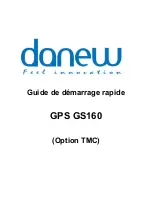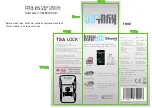
NEO-5
-
Hardware
Integration
Manual
Preliminary
Product
Testing
GPS.G5-MS5-08003-A2
u-blox
proprietary
Page 45
The
second
problem
is
more
common
but
also
regularly
proves
to
be
hard
to
solve.
Here,
the
emitting
source
is
not
well
specified
and
the
emission
can
be
of
broadband
nature,
making
specific
countermeasures
very
difficult.
Moreover,
the
GPS/GALILEO
band
is
far
beyond
the
1
GHz
limit
that
applies
to
almost
all
EMC
regulations.
So,
even
if
a
device
is
compliant
with
respect
to
EMC
regulations
it
might
severely
disturb
a
GPS
receiver.
If
the
GPS/GALILEO
antenna
is
to
be
placed
very
close
to
some
other
electronics,
e.g.
the
GPS/GALILEO
receiver
itself
or
a
PDA-like
appliance,
the
EMC
issue
must
be
taken
very
seriously
right
from
the
concept
phase
of
the
design.
It
is
one
of
the
most
demanding
tasks
in
electrical
engineering
to
design
a
system
that
is
essentially
free
of
measurable
emissions
in
a
given
frequency
band.
C.2 Eliminating Digital Noise Sources
Digital
noise
is
caused
by
short
rise-times
of
digital
signals.
Data
and
address
buses
with
rise-times
in
the
nanosecond
range
will
emit
harmonics
up
to
several
GHz.
The
following
sections
contain
some
general
hints
on
how
to
decrease
the
level
of
noise
emitted
from
digital
circuit
board
that
are
potentially
in
close
proximity
to
the
GPS
receiver
or
the
antenna.
C.2.1 Power and Ground Planes
Use
solid
planes
for
power
and
ground
interconnect.
This
will
typically
result
in
a
PCB
with
at
least
four
layers
but
will
also
result
in
a
much
lower
radiation.
Solid
ground
planes
ensure
that
there
is
a
defined
return
path
for
the
signals
routed
on
the
signal
layer.
This
will
reduce
the
“antenna”
area
of
the
radiating
loop.
Planes
should
be
solid
in
a
sense
that
there
are
no
slots
or
large
holes
inside
the
plane.
The
outer
extent
of
the
power
plane
should
be
within
the
extent
of
the
ground
plane.
This
avoids
that
the
edges
of
the
two
planes
form
a
slot
antenna
at
the
board
edges.
It’s
a
good
idea
to
have
a
ground
frame
on
the
circumference
of
every
layer
that
is
connected
to
the
ground
plane
with
as
many
vias
as
possible.
If
necessary,
a
shield
can
then
be
easily
mounted
on
top
of
this
frame
(see
Furthermore,
free
space
on
the
outermost
Layers
can
be
filled
with
ground
shapes
connected
to
the
ground
plane
to
shield
radiation
from
internal
layers.
Bad: Excessive Radiation
Good: Radiation terminated
Figure 29: Signal and power plane extends should lie within ground plane extends
Optional shield
Figure 30: Further improvement of reduction of power plane radiation










































